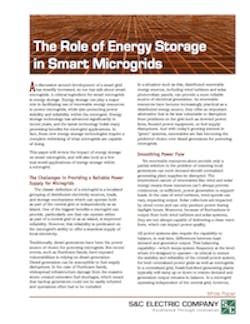As discussion around development of a smart grid has steadily increased, so too has talk about smart microgrids. A critical ingredient for smart microgrids is energy storage. Energy storage can play a major role in facilitating use of renewable energy resources to power microgrids, while also protecting power stability and reliability within the microgrid. This technology has advanced significantly in recent years, and the latest technology holds many promising benefits for microgrid applications. In fact, these new technologies require a complete rethinking of what microgrids are capable of doing.
Some of the topics discussed in this paper include:
- Providing a Reliable Power Supply for Microgrids
- Balancing Power Flow and Quality
- Integrating Renewable Resources in to a Smart Microgrid
- Seamless Transition to Backup Generation
- Microgrids and Energy Storage Case Studies
This paper will also look at a few real-world applications of energy storage within a microgrid.
The Challenges in Providing a Reliable Power Supply for Microgrids
The classic definition of a microgrid is a localized grouping of distributed electricity sources, loads, and storage mechanisms which can operate both as part of the central grid or independently as an island. One of the biggest benefits a microgrid can provide, particularly one that can operate either as part of a central grid or as an island, is improved reliability. However, this reliability is predicated on the microgrid’s ability to offer a seamless supply of local electricity.
Traditionally, diesel generators have been the power source of choice for powering microgrids. But recent events, such as Hurricane Sandy, have exposed vulnerabilities in relying on diesel generation. Diesel generation can be susceptible to fuel supply disruptions. In the case of Hurricane Sandy, widespread infrastructure damage from the massive storm created extensive fuel shortages, which meant that backup generators could not be easily refueled and operations often had to be curtailed.
